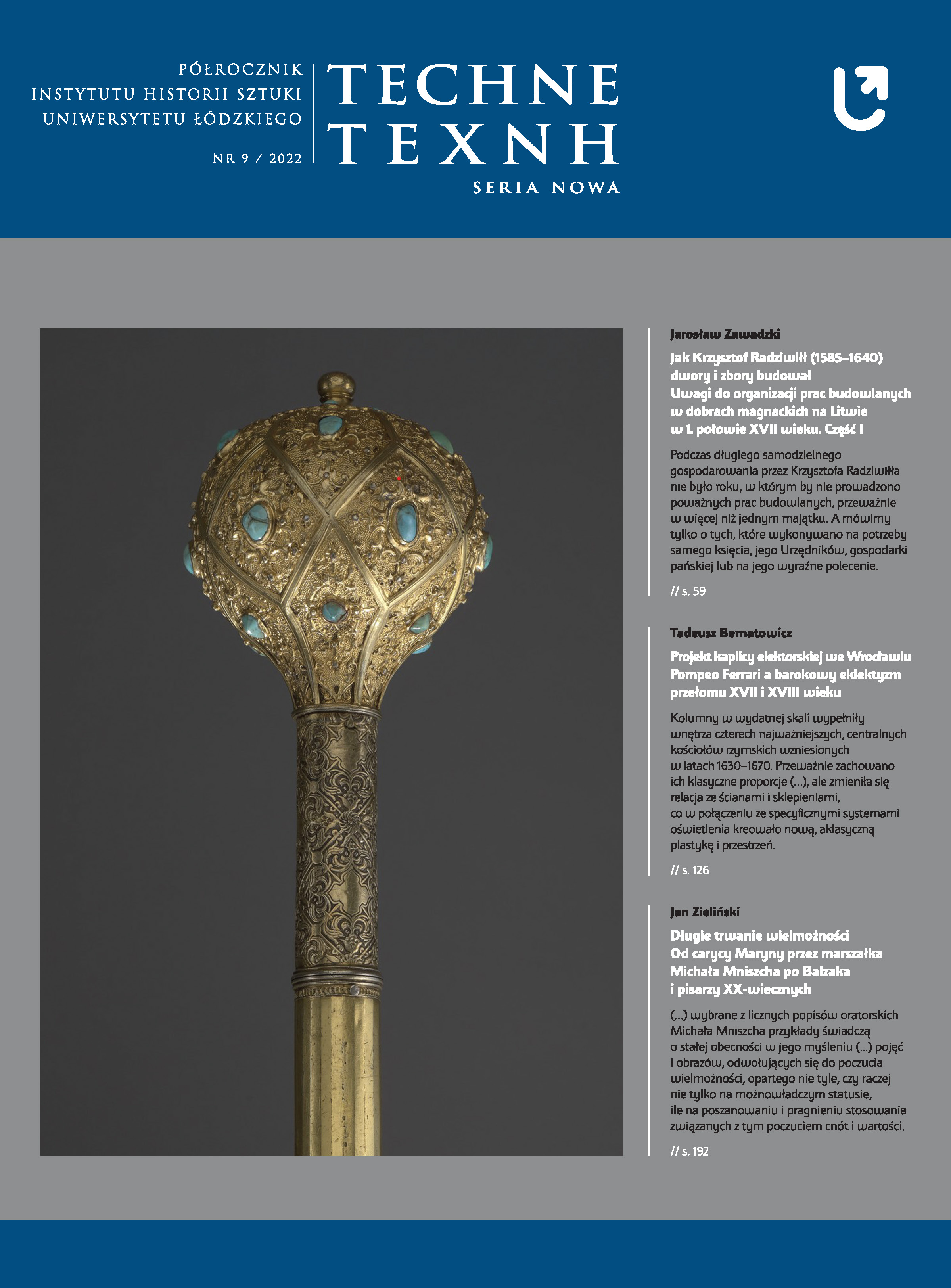Hetman’s investments in the 17th century. Between self and state interest
DOI:
https://doi.org/10.18778/2084-851X.13.03Keywords:
Eastern Borderlands, hetmans, Pidhirtsi, Zhovkva, 17th century, fortificationsAbstract
At the end of the 16th century, the principle of the lifelong functioning of the hetman’s office was established. Perhaps it is no coincidence that the performing of hetmans function resulted in large-scale, sometimes exceptionally modern investments, they were: Zamość, Żołkiew, Brody, Stanisławow, Kudak and Okopy Św. Trojcy. The defense of the south-eastern borderland territories, where the hetmans had their greatest latifundia, initiated the creation of fortresses, centers of these latifundia, and at the same time created an effective system of defense of the entire state against Tatar and Turkish threats and Cossack uprisings. Stanisław Koniecpolski stood out, initiating the creation of a number of smaller fortresses – the most famous of them is Kudak - or Nowy Koniecpol, strengthening Bar with more modern fortifications, thinking about creating a Knight School in Lviv. What is worth emphasizing is the evolution of defense devices from simple bastions like in Żołkiew, through Brody bastions to modern, with panache designed fortifications surrounding Lviv at the end of the 17th century built on the initiative of Hetman Stanisław Jabłonowski. Another interesting problem are the mutual relations between the fortress and the residence, such as Brody and Podhorce, Lviv and Podkamień. The hetman-latifundists did not try to modernize the acquired older castles, such as Stanisław Koniecpolski, who did not modernize the sixteenth-century bastion system of castles in Mikuliniec and Jazłowiec. The Hetman’s office began to function as a permanent element of the political system of the Republic of Poland relatively late, so the hetman’s presence in the Senate was ensured by such additional dignities as the chancellor’s office – Zamoyski, Żołkiewski, and the castellan of Krakow – Koniecpolski, Jabłonowski. Only Stanisław Koniecpolski felt the need to emphasize his additional dignity by founding in the capital of Myślenice eldership, which was an endowment of the castellan dignity, in Myślenice a chapel for the miraculous image of the Blessed Virgin Mary. Summing up, the founding initiatives of the hetmans as state ministers and latifundists in the 17th century are extremely closely intertwined, which resulted from their involvement in the organization of the protection of their own estates most often located in the eastern borderlands of the country, particularly exposed to military actions in the 17th century.
References
ADAMCZYK 2004 – Jan Leszek Adamczyk, Fortyfikacje stałe na polskim przedmurzu od połowy XV do końca XVII wieku, Kielce 2004.
Google Scholar
AFTANAZY 1990 – Roman Aftanazy, Brody, [w:] Materiały do dziejów rezydencji, t. VIIa, Warszawa 1990, s. 259–266.
Google Scholar
BEAUPLAN 1972 – Eryka Lassoty i Wilhelma Beauplana opisy Ukrainy, Warszawa 1972.
Google Scholar
BOGDANOWSKI 1976 – Janusz Bogdanowski, Fortyfikacje łańcuckie na tle małopolskiej sztuki obronnej, Łańcut 1976.
Google Scholar
DŁUGOSZ 1972 – Józef Długosz, Mecenat kulturalny i dwór Stanisława Lubomirskiego wojewody krakowskiego, Wrocław 1972.
Google Scholar
DYBAŚ 1998 – Bogusław Dybaś, Fortece Rzeczypospolitej. Studium z dziejów budowy fortyfikacji stałych w państwie polsko-litewskim w XVII wieku, Toruń 1998.
Google Scholar
GAWRON 2010 – Przemysław Gawron, Hetman koronny w systemie ustrojowym Rzeczypospolitej w latach 1581–1646, Warszawa 2010.
Google Scholar
GUERQUIN 1966 – Bohdan Guerquin, Zamek Jazłowiecki, Studia i materiały do teorii i historii architektury i urbanistyki II, Warszawa 1966.
Google Scholar
HORN 1962 – Maurycy Horn, Chronologia i zasięg najazdów tatarskich na ziemie Rzeczypospolitej Polskiej w latach 1600–1647, „Studia i Materiały do Historii Wojskowości” 1962, t. VIII, z. 1, s. 3–71.
Google Scholar
KAJZER/KOŁODZIEJSKI/SALM 2001 – Leszek Kajzer, Stanisław Kołodziejski, Jan Salm, Leksykon zamków w Polsce, Warszawa 2001.
Google Scholar
KERSTEN 1973 – Adam Kersten, Jerzy Sebastian Lubomirski, [w:] Polski Słownik Biograficzny, t. 18, Warszawa 1973, s. 14–19.
Google Scholar
KRAWCOW 1992 – Sergiej R. Krawcow, O układzie przestrzennym miasta Brody w XVI–XVII w., „Kwartalnik Architektury i Urbanistyki” 1992, t. XXXVII, z. 1, s. 3–15.
Google Scholar
KRAWCOW 1993 – Sergiej R. Krawcow, Stanisławów w XVII–XVIII w. Układ przestrzenny i jego symbolika, „Kwartalnik Architektury i Urbanistyki” 1993, t. XXXVIII, z. 1, s. 3–20.
Google Scholar
KUŚNIERZ 1984 – Kazimierz Kuśnierz, Sieniawa. Założenie rezydencjonalne Sieniawskich. Rozwój przestrzenny w XVII oraz XVIII wieku, Rzeszów 1984.
Google Scholar
NOWAK 1970 – Tadeusz Nowak, Próba założenia wojskowej uczelni technicznej w Polsce w XVII w., [w:] Polska technika wojenna XVI–XVIII w., Warszawa 1970, s. 117–140.
Google Scholar
PETRUS 1997 – Jerzy T. Petrus, Żółkiew i jej kolegiata, Warszawa 1997.
Google Scholar
Downloads
Published
How to Cite
Issue
Section
License

This work is licensed under a Creative Commons Attribution-NonCommercial-NoDerivatives 4.0 International License.








